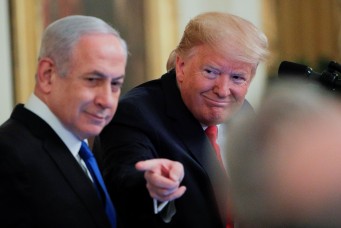A Resurgent Trump Returns to a Turbulent Middle East
Trump’s unpredictable yet forceful leadership is entering a region in flux, offering both challenges and opportunities for his second term

Trump’s first victory in 2016 could be considered an aberration; his resounding return in 2024, however, indicates a more permanent change in American politics and policy. Meanwhile, the Middle East itself has experienced profound changes in the past year and a half. How will these two dynamics interact in the four years ahead?
Trump came back to the White House on January 20, 2025 with vastly more governance and policy experience than he did in 2017. In foreign and Middle East policy, he is better acquainted with the regional developments and players and has had time to express his preferences on key issues.
In the first term, Trump’s team was composed mainly of foreign policy and defense veterans. As he learned his way through foreign policy, he often deferred to his team. This time around, he comes equipped with more self-confidence; the team around him is well aware that their job is to implement his policies rather than push back against them. His political mandate, as he sees it, is to double down on his America First bilateral and transactional approach to foreign policy, and to—even more than before—“Let Trump be Trump”.
His foreign policy team and his political supporters may be united in their support of, or fealty to, Trump, but they bring different approaches to foreign policy issues. His vice president and other members of his team and base are largely foreign policy isolationists, opposing major military or political entanglements abroad and wanting to focus on securing the border and socio-economic development at home.
Others, like his secretary of state and those in the old wing of the Republican party, are traditional hawks; they interpret America First as America Dominant in the world. They decry the image of weakness that Biden projected during his term and favor the use of American power to confront opponents or seek advantages in foreign policy. Meanwhile, his evangelical base sees the world in Christian messianic terms, which is relevant especially in issues related to Israel, Palestine, and the holy land.
The team Trump has assembled so far represents the broad spectrum of these foreign policy approaches. And even though it will be Trump who will be calling the shots—in this term even more than the last—it is instructive to review the team he has assembled so far. Of course, his members will have to survive serving with Trump, who has a penchant for firing and replacing associates at a dizzying pace.
For secretary of state he has selected Marco Rubio, the senator from New York; Rubio has extensive foreign policy experience in the Senate and can be described as a traditional republican hawk. His focus will most likely be centered primarily on China and Ukraine, as well as South America. For secretary of defense he has selected Pete Hegseth, a military veteran and Fox News commentator who falls into the fairly radical evangelical and messianic wing of the party; Hegseth would not hesitate to use force. He is a strong supporter of Israel on supposed Biblical grounds and a harsh critic of Iran. As national security advisor Trump has named Michael Walz, a strong hawk known most for his hard line on China, but also an avid supporter of Israel and critic of Iran. Other team members fall into similar camps, including the U.S. ambassador to the United Nations, Elise Stefanik, the director of national intelligence Tulsi Gabbard (whose appointment is still awaiting senate confirmation), and the head of the CIA John Ratcliffe.
His Mideast team generally has a similar bent, including U.S. ambassador to Israel Mike Huckabee (awaiting senate confirmation) and U.S. special envoy to the Middle East Steve Witkoff. Of a different cloth one would count Eric Trager, who is heading the Middle East team at the National Security Council; Trager is a think tank and D.C. veteran who will likely take a more pragmatic and analytical approach to Middle East policy issues. Massad Boulos is a family relative by marriage to the Trumps and has been named advisor to the President for Middle East Affairs; he is a Lebanese-American businessman and would likely counsel a practical and even-handed approach to the region.
Of course, at the end of the day, it will be Trump who calls the shots among these different camps of Republican foreign policy. Trump brings several of his own idiosyncrasies to the equation. He has little regard for democracy, rule of law, or human rights and seems to prefer dealing with authoritarian leaders, who certainly abound throughout the Middle East.
He prides himself on projecting U.S. power, menace, and unpredictability, and wants to use these factors to U.S. advantage. Unlike Biden and previous Republican leaders, he does not see his role as preserving the U.S.-led post-World War II order, but rather sees himself as a disrupter, breaking out of old alliances and patterns and finding new ways to advance American interests; this might partly explain his affinity for tech titans like Elon Musk and others who see their task as disrupting the old economies and technologies and building new ones.
In recent weeks, Trump has emphasized a particularly troubling aspect of his abandonment of the post-WWII order by stating plainly that the United States, due to “national security interests”, should consider taking over the Panama Canal and seizing or “buying” Greenland; he has also argued that the United States should encourage Canada to abandon its independence and become a U.S. state. Of course, this flies in the face of the basic rules of international law and order enshrined in the United Nations that the United States has defended for the past eight decades. But it would be music to the ears of Putin, Netanyahu, or others who are doing the same.
The mixed bag of the Republican camps, combined with Trump’s own unpredictable character and rapidly changing positions (which he prides himself on), make it clear that the second Trump presidency will certainly be impactful, but potentially chaotic.
The unpredictable nature of Trump’s approach revealed itself in spades when Trump made the surprise announcement on February 6 that the United States would take over the Gaza Strip, displace its entire Palestinian population, and redevelop it to become the “Riviera of the Middle East”. His announcement came as a shock to the Arab and Muslim states, who almost unanimously rejected the proposal. It even took Israeli Prime Minister Netanyahu aback: he had come to Washington to seek U.S. support for an Israeli strike on Iran. Trump made clear that he did not support a strike but rather favored a deal with Iran, and threw the Gaza proposal on the table. He also said cryptically that he would make an announcement on the West Bank soon. True to form, Trump has barged into Middle East politics with a high level of impact and a high dose of unpredictability.
An Especially Turbulent Time in the Middle East
The Middle East itself is in a very different place than when Trump took office in 2017. Back then, the Palestinian issue was largely off the regional agenda. Israel’s occupation of the West Bank and siege of Gaza, partly enabled by cooperation with the Palestinian Authority in the West Bank and what Israel presumed was a tacit understanding with Hamas in Gaza, appeared largely stable and sustainable. Based on that assumption, the Trump administration proceeded with normalization agreements between Israel and four Arab countries without having to grapple with the Palestinian issue or the fate of the West Bank and Gaza.
Meanwhile, Israel and Iran appeared to be in a situation of sustained balance of power and mutual deterrence. This particularly applied to Israel and Iran’s main militia ally, Hezbollah; the mutual deterrence established after the 2006 war appeared to be durable. The same scenario seemed to apply to Israel’s relationship with Hamas after the latter took over Gaza in 2007. In both cases, Israel calculated that these armed groups might harass Israel but would not risk an all-out war and that Iran was only interested in defensive deterrence and would not risk major offensive action. This was proven wrong on October 7, 2023, when Hamas launched its major cross border incursion, and on October 8, when Hezbollah opened a second front from Southern Lebanon.
These developments have caused profound changes in the Middle East. On the one hand, the Netanyahu government and much of Israeli public opinion has moved further to the right, supporting a long war of devastation in Gaza and an escalation of violence against Palestinians in the West Bank. On the other hand, the ferocious Israeli response over the past year has inflamed Arab and Muslim public opinion (in addition to significant shifts in public opinion in Europe and sectors of the United States) and has made ignoring the Palestinian issue in any future regional diplomacy virtually impossible.
On the Israeli-Iranian side of the ledger, Iran moved first to abandon the defensive deterrence model when its allies moved to offense in October 2023; Iran and its allies perhaps figured that Israel was divided and hence vulnerable, and that the Biden administration was also weak and would not put up a robust response. Over the ensuing months, Israel completely turned the tables on this false calculation with strong support from the United States. Israel not only wiped out most of Hamas, but also undertook the largest devastation of Palestinians since the Nakba of 1948.
Additionally, Israel ended almost two decades of a presumed balance of power and deterrence with Hezbollah by undertaking a stunning series of attacks against the armed group that wiped out its top leadership, killed and wounded thousands of its fighters, destroyed a large portion of its arms, and displaced over a million Lebanese from towns and villages that Hezbollah claimed it existed to defend.
By neutralizing Hezbollah, Iran’s main deterrent against Israel and the United States, Israel had achieved a strong imbalance of power in its favor. Iran itself became vulnerable, as demonstrated by Israel’s direct attacks on Iranian air defenses that were undertaken in October of last year. Geopolitics, by nature, abhors power imbalances, and the current Israeli-Iranian imbalance is only temporarily on pause; unless dramatic diplomacy intervenes, another conflict is likely to break out with Israel pressing its military advantage.
In the last weeks of the Biden administration, another transformative event struck the region with the melting away of the Assad regime in the face of an opposition attack led by the Turkish-backed and former al-Qaeda affiliate HTS. The fall of the Assad regime was partly the result of Israel’s weakening of Hezbollah and Iran, but also the result of Moscow’s distraction in Ukraine and the internal dynamics of the Syrian civil war and the many missteps of the Assad regime. In any case, the fall of the Assad regime was another staggering blow to Iran and Hezbollah and a victory for Turkish (and Qatari) influence. Globally it was a blow to Russia and an unexpected potential boon to the United States. The trajectory that Syria takes in the coming months will cast a long shadow on all its neighboring countries, including Lebanon, Jordan, Iraq, Israel and Turkey.
The Trump Trajectory in the Middle East
How will the incoming Trump administration deal with these challenges and opportunities in this turbulent Middle East? As mentioned above, Trump has started with a major announcement that no one expected, declaring that the United States would take over the Gaza strip. Although it is not clear how the United States could actually follow through on such a plan, Trump has doubled down on his statement and both Arab governments and Israel are in the process of trying to figure out how to deal with it.
The unknown element in this equation is what will Trump announce vis-a-vis the West Bank? There are two scenarios: either he makes an equally pro-Israeli-right-wing announcement that includes large scale annexation by Israel of its settlements and more displacement of Palestinians, or he pivots from his Gaza announcement (that greatly satisfies the Israeli right wing) to propose something different for the West Bank in order to secure the much sought after deal with Saudi Arabia.
The Kingdom has made it clear that normalization with Israel will require a solid pathway for some kind of Palestinian statehood. Trump might give the Israeli right wing its wish in Gaza, but in exchange he may propose a sharing of the West Bank with a Palestinian entity which might have the nomenclature of a state without real aspects of state sovereignty. This would be similar to the “Deal of the Century” that he put on the table in 2020, but minus Gaza. The tripartite deal between the United States, Saudi Arabia, and Israel would not only complement the string of Abraham Accords that he achieved in his first term, but would also cement Saudi Arabia in the American camp in the global contest against China.
In Lebanon, the Trump team is insisting that the ceasefire agreement be implemented by February 18, with a full withdrawal of Hezbollah north of the Litani river and a strong presence of the Lebanese army and UNIFIL in that area, as well as a full Israeli withdrawal. The election of the head of the Lebanese army, General Joseph Aoun, to the presidency on January 9, and then the election of an independent and respected international judge, Nawaf Salam, to the post of prime minister are both positive steps in that direction. The Trump administration will also press for the ensuing disarmament of Hezbollah, but this will be a much harder goal for Lebanon to achieve. At the end of the day, the full disarmament of Hezbollah is a decision that will most likely have to be taken in Tehran and might come about only as the result of a combination of maximum pressure and tough negotiations with Iran.
Iran will be another complex issue that the new administration will have to tackle. The scenario favored by Israel would be a U.S.-supported Israeli large-scale strike (or strikes) on a vulnerable Iran that will set back its nuclear program many years, shake the stability of the regime, and, at a minimum, force the Islamic Republic to serious talks and concessions. Many members of the Trump team would favor this option, except that Trump ran his campaign on keeping America out of new wars, especially in the Middle East. Since he reassumed power, he has reimposed strong sanctions on Iran, but he has made clear that he does not favor war, but rather a negotiated outcome. The most likely scenario is an extended no-war, no-negotiated-breakthrough with Iran. This will not be a comfortable situation for Israel, but it might not be able to go against Trump’s wishes.
The continuing attacks by the Houthis on Red Sea shipping are also hanging over the region. A Trump administration will want to take action to try to neutralize this threat, but there are no easy military options. If the United States and Iran end up in talks, defusing the Houthi activities will be high on the U.S. agenda.
Vis-a-vis Syria, the Trump administration welcomed the fall of the Assad regime as a loss for Iran, Hezbollah, and Russia, and an indirect “win” for the United States. Trump has good relations with Turkish President Recep Tayyip Erdoğan and does not mind the strong Turkish influence in the emerging Syria. The United States will continue to use its enormous leverage on the issue of lifting of sanctions to push the new HTS-led government in Damascus to implement an inclusive transition and stay well away from the radicalism of its early al-Qaeda days. A key decision Trump will face in 2025 is whether to withdraw U.S. troops from Syria or not. He will certainly favor pursuing a U.S. withdrawal soon, but might use the leverage that the presence of troops grants him to gain advantage and avoid an embarrassing withdrawal like that of Biden from Afghanistan.
Setting these conflict areas aside, Trump is first and foremost a businessman whose mandate is to bring back American prosperity. In that vein, his interests in Saudi Arabia and the Gulf will be front and center. His first foreign visit during his initial term was to Saudi Arabia; it might be so again this time. The centrality of economic interests related to energy, trade, investment, technology, space, and other future economic sectors will be core issues for Trump.
It is said about the Middle East that one must always expect the unexpected; the same can be said about Trump himself. How these interests, conflicts, and attitudes sketched out above will evolve and interact in the months ahead will be something to watch closely. As Donald Rumsfeld once remarked, there are known knowns, known unknowns, and unknown unknowns; in trying to predict Trump’s decisions and actions in a fast changing Middle East, the third category might be the most relevant.




